William & Mary
2019
- Population status of diamondback terrapins on the Catlett Islands. Abbi Belvin ’20 and Justin Mitchell ’20.
-
We completed a mark-recapture study of terrapins from the Catlett Islands on the York River in Virginia (part of the Chesapeake Bay National Estuarine Research Reserve). Our objective was to estimate the size and determine the demographics of the terrapin population from a location that had not been studied previously. From May 30th to July 26th 2019, five crab pots were placed at two locations around the Catlett Islands. Each pot was modified with a 120-cm chicken wire chimney to allow trapped terrapins access to the surface for air. The pots were baited with menhaden on Mondays and Wednesdays each week, then cleared of crab catch and terrapins Tuesday-Friday (pots were left open on the weekends). The carapace length, width, and shell depth of each terrapin was recorded, and their shells were notched for identification in case of recapture. Over the 9-week study, 78 turtles were caught, with 0 recaptures (Figure 1). On average ± SD, terrapin captures were greater on the first day following baiting than the second day, but not significantly so (2.5 ± 3.7 vs 1.8 ± 2.0 terrapins d-1). Of the turtles captured, 34 were females and 44 were males. Age ranged from 2 years to 9+ years, and carapace length ranged from 6.7 cm to 20.6 cm. None of the females was gravid, based on abdomen palpitation. Five terrapins were found with leg or foot injuries, and one was found deceased in a pot with a wound to its neck, likely from the concomitant catch of crabs (on average, 2.1 crabs pot-1 d-1). Despite the loss of 30 terrapins drowned in a ghost pot prior to the start of the study, the population of diamondback terrapins from the Catlett Island ecosystem appears robust. No recaptures in a 9-week period within the same location is unusual (Table 2) and points to an abundance of terrapins. We doubt that terrapins are leaving the island complex as transients or behaviorally are avoiding a second capture.
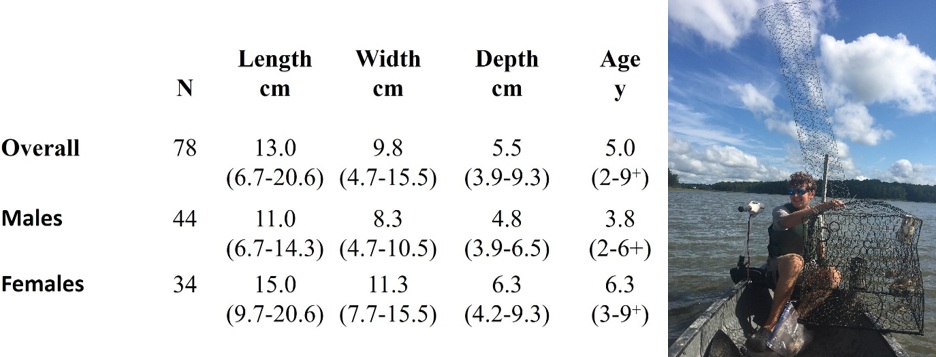
-
- Sustainability in Chesapeake shorescapes: A comparison of habitat support for grass shrimp in living shoreline and natural marshes. Ansley Levine ‘20
-
Grass shrimp (Palaemonetes pugio) populations were compared between 9 pairs of living shoreline and natural marsh sites in the southwestern portion of the Chesapeake Bay. Specifically, shrimp population demographics (length and sex ratios) and gut contents were studied over 7-weeks during June and July 2019 to compare between living shoreline and natural marsh shrimp populations. The study assessed whether living shorelines are approaching similar functionality of natural marshes by addressing two main questions: (1) Does average shrimp length or proportion of total gravid females differ in living shorelines versus natural marshes? (2) Do living shorelines provide different nutritional resources for grass shrimp than natural marshes, or do differences in diet vary more by location than marsh type? In general, shrimp populations differed more among site pairs from different locations than between created and natural marshes from the same location. From summer sampling, no major differences were found in population demographics considering average shrimp length and proportion of gravid females from 9 site pairs. Gut content analysis of shrimp from 7 marsh pairs demonstrated that diets did not significantly differ between marsh types. LS sites were found to be emptier on average than NM sites and contained more fine particles. In addition, the shrimp appeared to eat more invertebrate debris in the LS habitats than the NM sites. At most sites, less than half of all guts dissected were empty, suggesting that shrimp were successful in obtaining dietary needs in both site types. Almost every site contained at least one unnaturally colored blue, pink or pale green unidentifiable filament or particle, all of which were assumed to be man-made plastic. The site pair in Norfolk appeared to have more plastic contamination in the guts than the other more northern Chesapeake sites near the York River or Mobjack Bay.
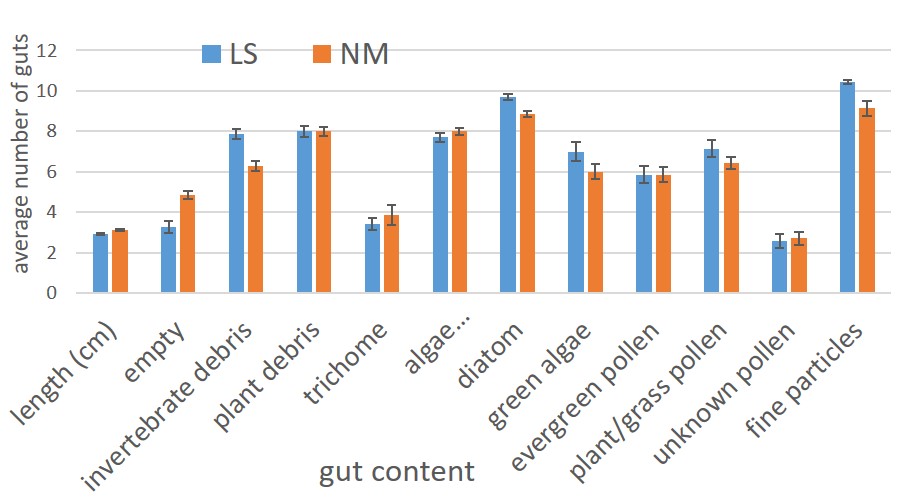
-
2018
- Greenhouse gas flux from stormwater ponds in southeastern Virginia. Giancarlo Racanelli ’19 and Abigail Belvin ’20.
-
Stormwater ponds are ubiquitous features of developed landscapes of the eastern United States. Their design specifically controls the pace of water runoff from impervious cover of surrounding watersheds. Ponds accumulate organic matter that typically decomposes anaerobically in bottom sediments, and thus may be significant sources of greenhouse gases to the atmosphere (e.g., carbon dioxide (CO2), methane (CH4)). We sampled fifteen stormwater retention ponds in southeastern Virginia (USA) during summer 2018 to determine the diffusive emission of greenhouse gases with respect to measured environmental parameters. The equivalent CO2 (CO2e) flux from ponds ranged from 8.3 to 80 mmol m-2 h-1, with CH4 contributing 94%, CO2 6% and nitrous oxide less than 1% of the CO2e flux, on average. From linear mixed-effects modelling, diffusive flux of CO2 was inversely associated with pH. Maximum depth best explained diffusive flux of CH4, with surface area of secondary importance, i.e. CH4 flux was higher in smaller and more shallow ponds. With 300 stormwater ponds in the county where we conducted this study, we estimate that, during a 100-day warm season, these ponds emit 2.3 × 109 ± 1.5 × 109 SD g C as CO2e. As small, human-constructed ponds are becoming common features of urbanizing landscapes globally, results from this study suggest that, collectively, small ponds can contribute substantially to climate forcing. Better pond designs that reduce sediment methanogenesis, however, can mitigate the hypothesized potential disservice of GHG emissions from unvegetated stormwater retention ponds.
-
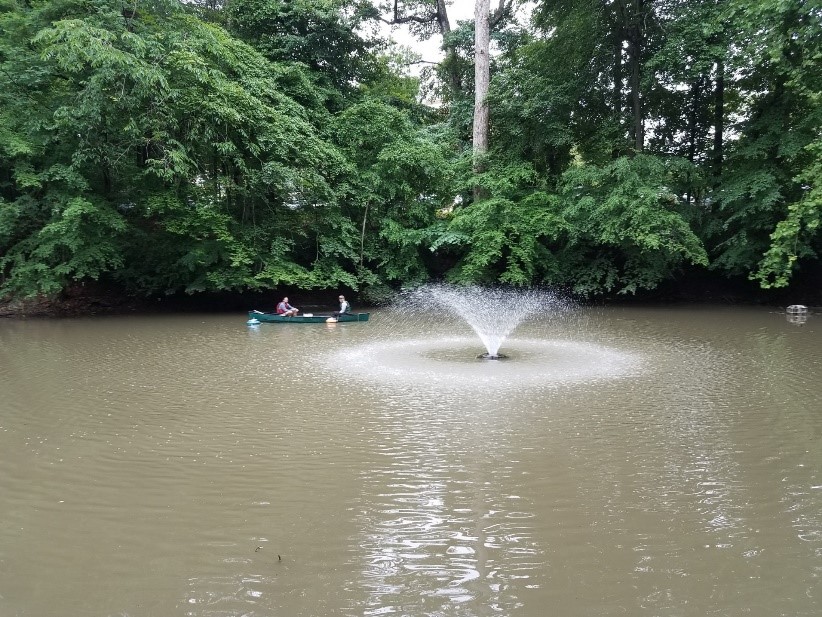
- A comparison of trophic support of grass shrimp (Palaemonetes pugio) in living shoreline and natural fringing tidal marshes. Elise Turrietta ’20.
-
As omnivores, grass shrimp are thought to feed on small bits of plant and animal material in tidal marshes and find protection from predators amongst the stems of grasses growing there. Because living shoreline marshes are created and recently planted with grasses, I hypothesized that habitat support for shrimp would not be fully developed in living shoreline marshes, relative to fully established, natural marshes. We did not, however, find any demographic measure to support my hypothesis. Instead, it appears that living shoreline marshes quickly establish trophic and overall habitat support for shrimp, as the number of gravid females, egg production, and egg quality were similar between living shoreline and natural marsh types.
-
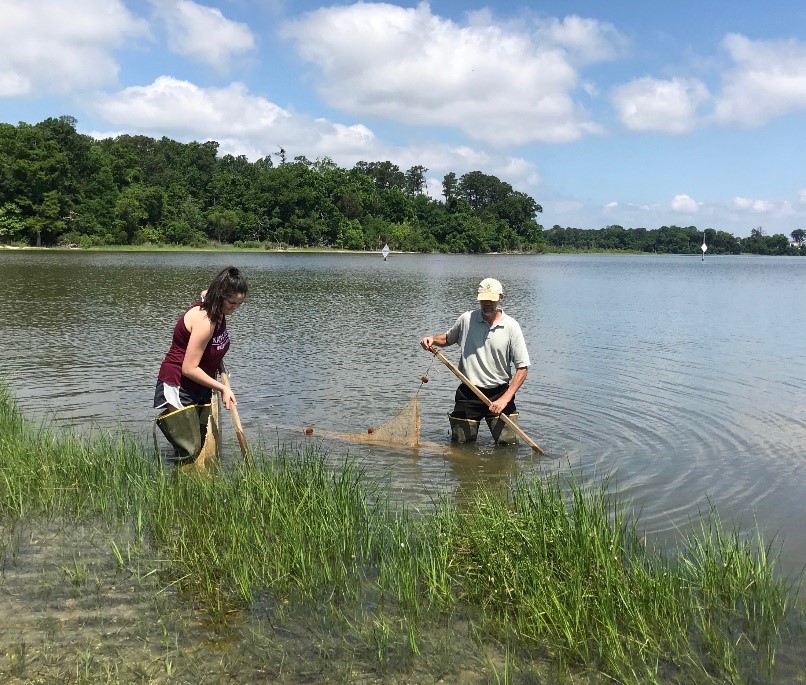
- Comparison of phosphorus content in created and natural tidal salt marsh soils. Jun Shi ’19.
- Natural salt marshes have been recognized for their ability to provide some level of coastal protection from wave-induced erosion and rising sea level. Efforts to mimic nature via construction of “Living Shorelines” can both protect the shorelines from erosion and mitigate coastal habitat fragmentation caused by riprap and bulkheads. S. alterniflora and S. patens are two of the most common plants used for Living Shoreline projects in the Chesapeake Bay area. For this research, I compared phosphorus content in soils from Living Shorelines in the Chesapeake area with that from adjacent, natural salt marshes. Because phosphorus is a critical nutrient for plant growth, I wanted to analyze the degree to which the Living Shorelines are approaching the structure and function of natural salt marshes. I found that the Living Shorelines marsh soils do not always have less total P than the natural salt marsh soils. While at some paired sites, the natural salt marshes exhibit more organic P, at other sites, the Living Shorelines marshes exhibit more organic P or similar amounts of organic P. Finally, different plant species from low (Spartina alterniflora) and high (Spartina patens) marshes do not contribute to different levels of phosphorus.
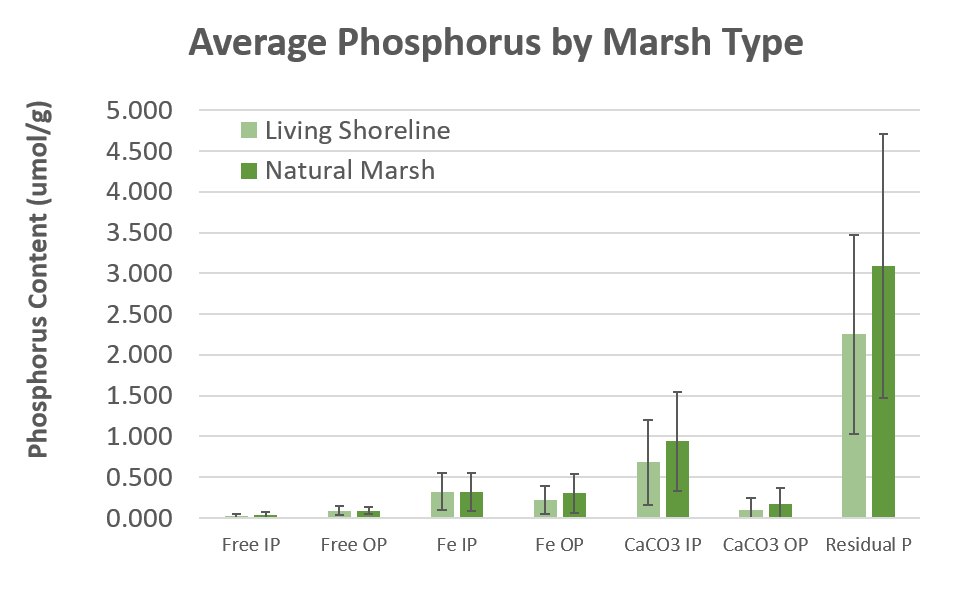
- Natural salt marshes have been recognized for their ability to provide some level of coastal protection from wave-induced erosion and rising sea level. Efforts to mimic nature via construction of “Living Shorelines” can both protect the shorelines from erosion and mitigate coastal habitat fragmentation caused by riprap and bulkheads. S. alterniflora and S. patens are two of the most common plants used for Living Shoreline projects in the Chesapeake Bay area. For this research, I compared phosphorus content in soils from Living Shorelines in the Chesapeake area with that from adjacent, natural salt marshes. Because phosphorus is a critical nutrient for plant growth, I wanted to analyze the degree to which the Living Shorelines are approaching the structure and function of natural salt marshes. I found that the Living Shorelines marsh soils do not always have less total P than the natural salt marsh soils. While at some paired sites, the natural salt marshes exhibit more organic P, at other sites, the Living Shorelines marshes exhibit more organic P or similar amounts of organic P. Finally, different plant species from low (Spartina alterniflora) and high (Spartina patens) marshes do not contribute to different levels of phosphorus.
-
Diamondback Terrapin nesting habitats and projected sea level rise. Holly Funkhouser ’19.
-
Diamondback terrapins are turtles that inhabit Virginia brackish waters of the Chesapeake Bay and the Eastern Shore. As a species reliant on optimal nesting sites on land, climate change and sea level rise will likely impact terrapin survival (Woodland et al. 2017). But where are those nesting sites in VA, and where will they shift with sea level rise? In parts of VA, “core habitat” for terrapin occupancy has been identified, but does not include nesting habitat. Our research examines how different environmental variables help describe current nesting habitat in Virginia. The goal is to use this information to predict how sea level rise will impact terrapin nesting habitat. We used ArcGIS to create the environmental layers and refine the sample data (terrapin nesting observations). The environmental layers consisted of metrics related to core habitat, salinity, beaches, and roads. The environmental data and the terrapin observations then went into a modeling program (Maximum Species Entropy Distribution Model) to create a map of diamondback terrapin nesting habitat in VA and projections of terrapin nesting habitat in 2030, 2050, 2075, and 2100.
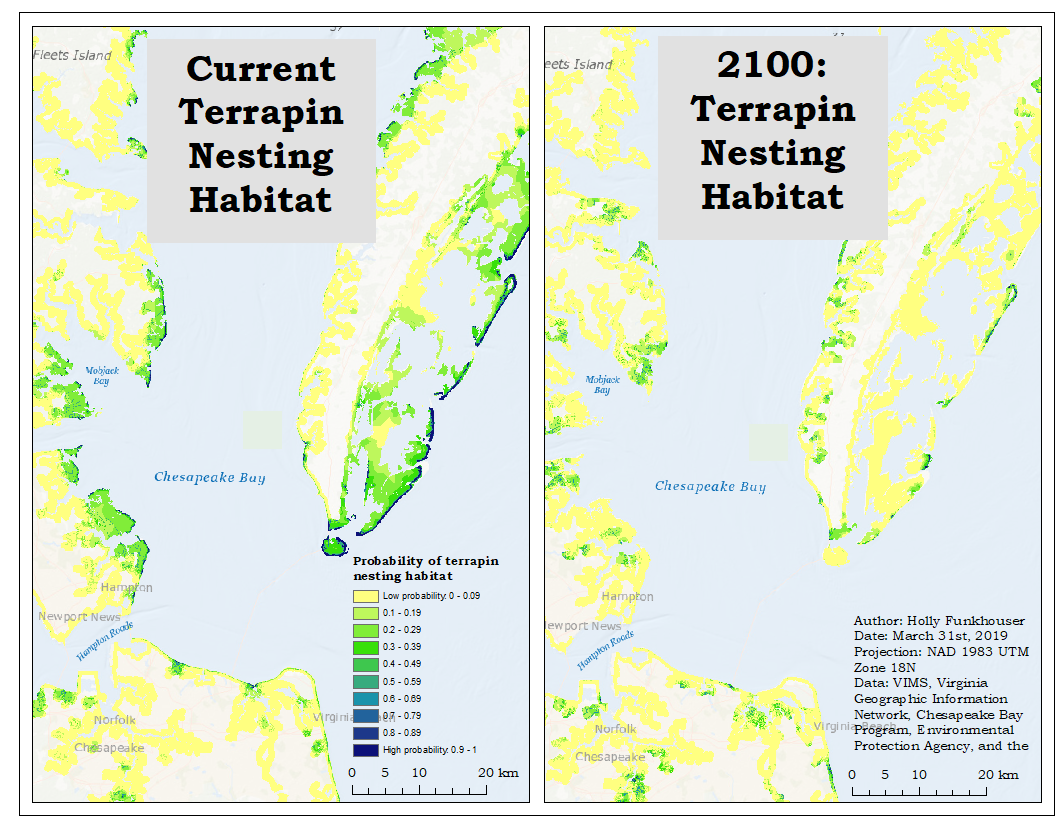
-
2017
- Greenhouse gas emissions from stormwater ponds. Carolina May (Biology)
- Can color alone reduce terrapin bycatch in commercial crab traps, without the need for bycatch reduction devices? Holly Funkhouser (Biology) and Jessica Wood (Christopher Newport University)
- Prior research has demonstrated that red bycatch devices (BRDs) inserted into the funnels of crab traps exclude terrapin bycatch and enhance the capture of preferred male blue crabs. We tried a trap modification for which no BRDs were installed; instead, we painted the funnels of the traps red, to test whether the effect observed with red BRDs would be similar with red funnels without BRDs. We fished baited crab traps in two tidal creeks during summer 2017, using 4 traps with black funnels and 4 traps with red funnels in each creek. Total legal crab catch was not significantly different between traps with red and black funnels (411 and 379, respectively), nor was there a significant difference in crab male:female sex ratio (red 22:1; black 25:1). Further, terrapin bycatch was not significantly different between traps with red and black funnels (26 and 27, respectively). Reduction in terrapin bycatch cannot be achieved using funnel color without reducing the size of the funnel opening, i.e., by installing a bycatch reduction device. The general absence of a color effect on the relative capture of male and female crabs may have been a result of ongoing biofouling of the trap funnels that over time obscured their colors. Chronic cleaning of the funnels was required to maintain full coloration.
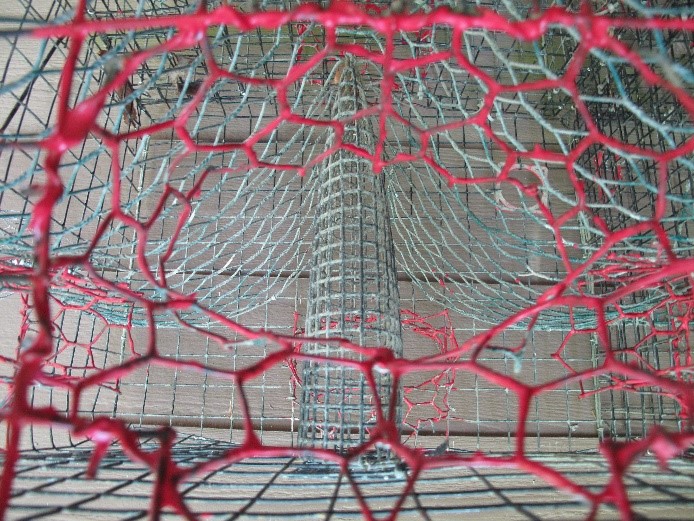
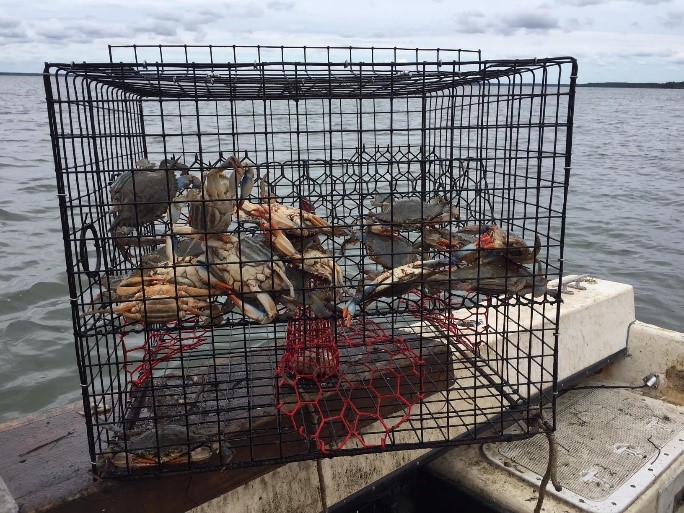
- Prior research has demonstrated that red bycatch devices (BRDs) inserted into the funnels of crab traps exclude terrapin bycatch and enhance the capture of preferred male blue crabs. We tried a trap modification for which no BRDs were installed; instead, we painted the funnels of the traps red, to test whether the effect observed with red BRDs would be similar with red funnels without BRDs. We fished baited crab traps in two tidal creeks during summer 2017, using 4 traps with black funnels and 4 traps with red funnels in each creek. Total legal crab catch was not significantly different between traps with red and black funnels (411 and 379, respectively), nor was there a significant difference in crab male:female sex ratio (red 22:1; black 25:1). Further, terrapin bycatch was not significantly different between traps with red and black funnels (26 and 27, respectively). Reduction in terrapin bycatch cannot be achieved using funnel color without reducing the size of the funnel opening, i.e., by installing a bycatch reduction device. The general absence of a color effect on the relative capture of male and female crabs may have been a result of ongoing biofouling of the trap funnels that over time obscured their colors. Chronic cleaning of the funnels was required to maintain full coloration.
2016
- A comparison of bycatch reduction devices for the blue crab fishery [pdf] Patrick Grubbs (Biology), Holly Funkhouser (Biology) and Peter Myer (International Relations)
2015
- Laboratory and field testing of red-colored bycatch reduction devices Andrew Corso (Biology)
- Testing the Waters: Relationships Among Land Use, BMPs, and Water Quality [pdf] Ryan Corcoran (Government)
2014
- Keeping terrapins out of crab traps: Do visual and other cues matter? [powerpoint] Jacqueline Huettenmoser (Geology) and Olivia Trani (Biology)
2013
- Modeling the effects of crab potting and road traffic on a population of diamondback terrapins [pdf] Sarah Gilliand (Biology)
2012
- The influence of recreational crabbing regulations on diamondback terrapin by-catch Amy Upperman (Biology)
2011
- Effect of water management on interannual variation in bulk soil properties from the eastern coastal Everglades [pdf] Rosemary Hatch (Geology)
2010
- An analysis of eutrophication in wetlands adjacent to Lake Matoaka [pdf] Kevin Quinlan (Geology)
2009
- The downstream effects of urban development of amphibian use of riparian wetlands [pdf] Allison Cornell (Biology)
- Water quality in stormwater ponds of James City County [pdf] Melissa Montagna (’10) and Michelle Mackenzie (’10)
- A test of by-catch reduction devices on commercial crabs traps in a tidal marsh creek in Virginia [pdf] Scott Morris (Biology) and Stephanie Wilson (Biology)
2008
- Selection imposed by crab fishery shifts turtle body size Matthew Wolak (Environmental Science and Policy)
- Bycatch reduction devices in crab traps reduce terrapin mortality Brett Bronner (Philosophy)
- Something Most Fowl: Geese and Water Quality in a Recreational Pond [pdf] Landon Rordam (Biology)
2007
- Green Roof at Sentara Williamsburg Regional Medical Center [pdf] Scott Morris (Biology)
- Diamondback Terrapin Turtles [pdf] Margaret Schrak, Jana Hartman and Megan First (Biology)
2006
- Does Nutrient Enrichment fron Adjacent Uplands Affect the Growth of Phragmites australis [pdf] Zack Hayden (Biology)
- Water Quality in the College Creek Watershed [pdf] Saji Perera (Biology)
- Heavy Metal in Sediments of Developed/Undeveloped Watersheds in Williamsburg [pdf] Holly Packard (Geology)
2005
- An Observation of Least Brook Lamprey (Lampetra aepyptera) Presence and Spawning Behavior in Five Tributary Streams of Lake Matoaka [doc download] Zack Hayden, (Biology)
2004
- Variation in Stream Plant Ecology as Related to Hydrological Changes Due to a Migrating Knickpoint [pdf] Jeremy Wacksman (Biology)
2003
- The Movements of Musk Turtles in Lake Matoaka Katie Andre (Biology)
- Methods and Data Analysis in Determining the Effects of Development on First-Order Streams [pdf] Diana Gibson and J. Twohy Murray (Geology)
- The Life History of the Gammarus pseudolimnaeus in the Chesapeake Bay Watershed: New Perspectives [pdf] Bethany R. Brookshire (Biology)
- History of Nutrient Loading in Lake Matoaka. Daniel Thomas (Biology)
2002
- Water quality of Lake Matoaka and its tributary streams [pdf] Bonnie Ludlow and Tim Wygant (Biology)
- Homing behavior in musk turtles [pdf] Christina Smar (Biology)
- Catchment hydrology in tributary streams of Lake Matoaka [pdf] Sharon Cardinal, Mike Pistorio, John Turcotte and Sara Bottenfield (Geology)
- Social and policy aspects of development in Williamsburg [pdf] Melanie Marzolf and Maureen Feldbaum (Sociology)
- Historical patterns of land use and trophic status of Lake Matoaka Mellisa Pensa (Biology) and Scott Vanbenschoten (History)
- GPS survey of campus trails Ryan McKinney (Geology)
- A chemical and fish survey of streams of the College Woods Adam Spiller and Morgan Sproul (Biology)
- Relationship between water depth and distribution of curly pondweed (Potomogeton crispus) in Lake Matoaka [pdf] Mellisa Pensa and Kate Wilkin (Biology)
2001
- Origin and evolution of high elevation Southern Appalachian plateaus Matthew L. Kirwan (Geology)
- Population ecology of musk turtles in Lake Matoaka Alison Holinka and Radhika Dave (Biology)
- Impacts of upland development on salamander abundance in downstream forested wetlands Kristen Murphy and Michael Turns (Biology)
- A population study of diamondback terrapins in Queens Creek Adam Spiller (Biology)















